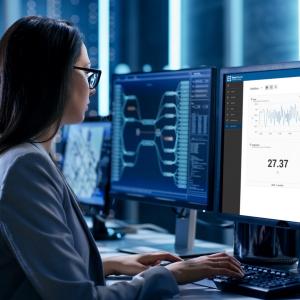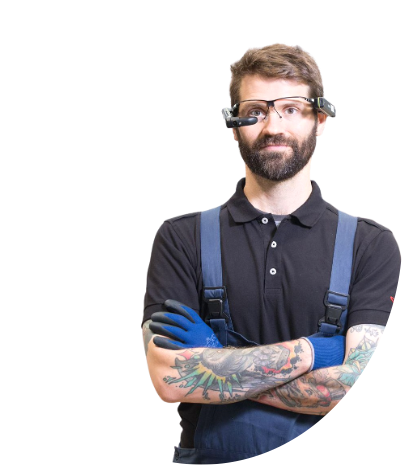“The Internet of Things (IoT) is the network of physical objects that contain embedded technology to communicate and sense or interact with their internal states or the external environment.” This is how Gartner* defines the Internet of Things. Thus, IoT supplies the foundation on which to build the factory of the future and Industry 4.0.
What state is my facility currently in? In analog times, the answer to this question could only be provided via a periodic check or an alarm. In the latter case, however, the damage had usually already been done and the production flow disrupted. For the company concerned, this meant additional costs, waiting times and, in many cases, problems with the customers if these were dependent on parts from the affected manufacturer for their business processes, for example. This jeopardized planning reliability just as it did customer satisfaction and, ultimately, the company’s ability to remain competitive.
Machines are now learning to “talk”
Meanwhile, however, digitalization has spawned the ways and means by which defects can be detected at an early stage, even before the damage actually occurs. This is made possible by the Internet of Things. This allows machines to be equipped with technology that allows them to sense and communicate their own states. This is usually done by means of appropriate sensor technology which records and transmits temperature data or vibration patterns, for example, i.e. machines have “learned” to provide information in response to the question “How are you?” which can then be automatically evaluated and interpreted.
This automated data evaluation is the core element of the concept of predictive maintenance. Through analyzing both historical and current data, signs of defects can be detected early on and appropriate steps taken.
Automated defect correction thanks to AI

Artificial intelligence (AI) is usually used to analyze large data volumes. When combined with IoT and automation, AI acts as a multi-level alarm system, taking the load off the employees. Here is an example: If the temperature within a machine rises, the system checks whether it returns to normal within a certain period of time. If this is the case, the event is simply documented internally. However, if the temperature does not drop during this time frame, AI triggers phase one: An employee is notified of the event by the IoT system without actually needing to take action.
The AI system then continues to monitor the situation: If the temperature remains at the same level – or even continues to rise – phase two comes into play: The cooling capacity is automatically increased and the system checks whether the temperature returns to normal as a result. The employee then receives a further notification. However, should the problem persist, human intervention is required. AI then alerts the employee and simultaneously provides him/her with all the important data. However, this person does not have to immediately rush over to the machine with a toolbox. Rather, the first stage includes carrying out a diagnosis remotely: Through IoT and remote access, the employee can connect to the machine’s software to research the cause of the defect, study the logs and evaluate the data right there in the system. Should the software be the cause of the defect, the employee can often take appropriate steps to resolve the issue or change the settings straight from his/her PC – irrespective of the location. Should the hardware be the cause of the defect, the employee is also provided with digital help via augmented reality (AR). And this is how it works:The expert and technician connect up either using their smart glasses or their smartphones. Both see the same image through the camera feed and, in addition to the voice connection, even have the option of placing visual markers – for example, by highlighting certain switches using an arrow or by putting rings around them to show that these must be pressed in order to identify the cause of the defect. This is a way of allowing employees to be guided through the steps by an expert right there on the spot – and of avoiding misunderstandings. One advantage this offers is that AR introduces another level of interaction that pure video imagery, for example, does not. Another advantage is that a worker has both hands free when using smart glasses so that he/she is even able to do complex repair work well.
Visual guidance and assistance
How a repair was actually carried out can also be recorded for training future employees. One way of enabling technicians to carry out maintenance without help from outside is by using detailed step-by-step instructions specially designed for smart glasses and supplied directly by the machine builder.
To ensure compliance and quality, the individual steps run through can be documented via the camera installed in the smart glasses. This is an important safeguard for both the employee and the company concerned. The next level in an AR-based maintenance system might be a combination of smart glasses and a personal AI assistant. Thanks to the way the latter has been trained, it recognizes the machine as soon as it sees it and provides the right instructions – without the employee needing to spend a long time searching for them. It also displays any important safety instructions that have to be observed during operation and maintenance work. These then need to be manually confirmed by the employee.
Combined with real-time data via a machine’s IoT system, the AI system can also make sure that the next repair or maintenance steps are only displayed once the machine confirms that it has been turned off by the employee. In this connection, the employee, acting as a “connected worker”, can benefit directly from the real-time data supplied by the machines, whereby he/she also produces data in a similar fashion which, in turn, can also be made use of – for example, to find out which parts have been replaced and need to be reordered. This also minimizes the risks that may arise, for example, from having forgotten to activate a safety switch.
AI is also useful during the actual repair work. For example, it assists the employee by indicating the correct tool to use. Although this in itself is “smart”, the system can also check and record, for example, that not only has a screw been tightened using the correct tool, but that this was also done using the required number of rotations and an appropriate amount of pressure. This makes it possible to improve your quality management system even further.
To sum up: Now that machines and systems are becoming increasingly intelligent and more closely networked, companies must ensure that the technical options for carrying out repair and maintenance work quickly keep pace with this development. After all, there is no point having the most modern production line if it is at a standstill for a longer period of time due to a defect which is taking too long to diagnose and repair. Digitization offers the tools to avoid this in the shape of AI, AR and IoT. At the same time, it also serves the purpose of carrying out remote maintenance in an increasingly globalized network. Now it is up to the companies to take advantage of these opportunities.
*Gartner Inc., Research and Advisory Company
Aditya Adavi
Aditya Adavi ist Director Product Management IoT bei der TeamViewer AG.

